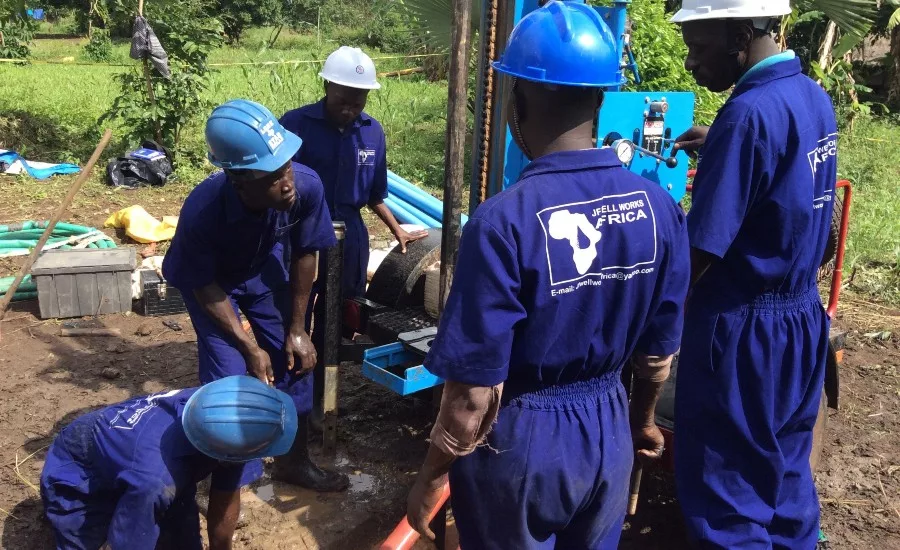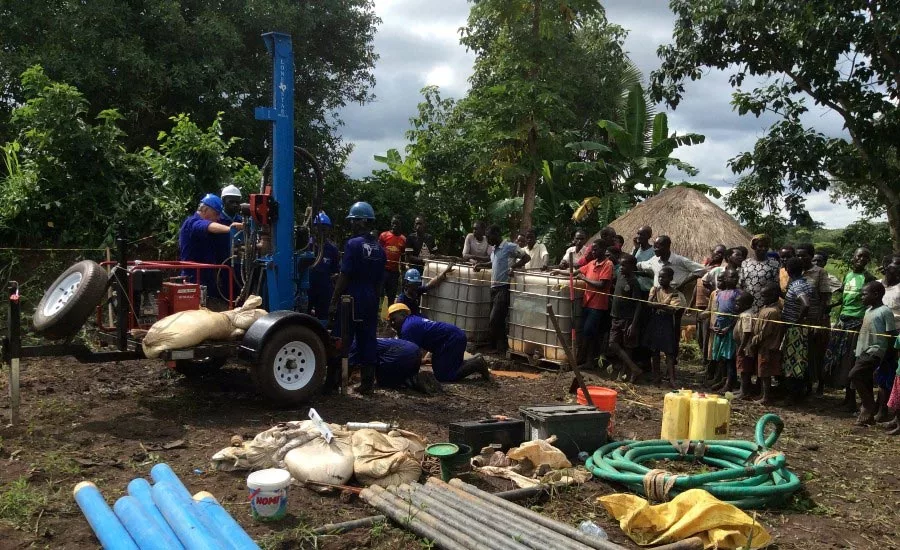Water Well Drill Helps Ugandans Dig out of Poverty
California Contractor Drills to Make a Difference for Rural Citizens

John Foley of JF Well Works Africa says the foundation has installed 220 water wells in three years using their Lone Star Drills LST1.
Source: Lone Star Drills

JF Well Works Africa says the areas it serves see immediate benefits, since having ready access to fresh water frees up rural citizens for more industrious things like farming and selling crops.
Source: Lone Star Drills
As the sun rises over the rural Ugandan valley, a group of 12-year-old girls gets ready for the day ahead. Instead of reaching for a backpack for school, each girl takes a 5-gallon jerrycan that will hold the water her family needs for the day. While 12-year-olds in other countries think about the latest fashion trends, sleepovers with friends or after-school activities, these girls from Uganda must sacrifice their schooling and any dreams of the future for a life sentence of carrying water.
The girls walk a few miles to get to the nearest water outlet — a 30-minute journey one way — and wait in line for everyone else to fill their jerrycans. Once filled, they carry the 5-gallon jugs, each weighing around 40 pounds, by hand because the terrain is too rough for wheelbarrows and other tools to lighten the load. Each of the girls comes home exhausted from the trip, but the day has only just begun.
A New Direction
On the other side of the world in Los Angeles, John Foley was working as a general contractor at the construction company he started in the early 1990s. He grew frustrated from constantly drowning in paperwork and felt keeping up the paper trail had become his job instead of the construction work he wanted to do. He knew it was time for a change, but never imagined he’d trade the streets of Los Angeles for a rural country in Africa to lay the groundwork that would change the way of life for Ugandan girls and their families.
“Back in the early 2000s I started looking for new opportunities and the need for water kept coming up,” Foley says. “In 2015, I visited Africa for the first time and noticed people would walk for miles just to get enough water for the day. The need for water was unbelievable and I knew I could do something to help.”
With his background in construction management, Foley’s leadership and problem-solving skills helped as he pitched the idea to a contact he found online, and together they decided to focus on drilling wells in Uganda. As one of the most densely populated countries in Africa and with 48% of the population under the age of 14, Uganda has a tremendous need for clean water. It is critical to the health of their people and a key to addressing the poverty issues afflicting the region.
“Most people in Uganda are farming or working in the agricultural sector for a living, and according to USAID, only 32% have access to a basic water supply,” Foley says. “Without access to clean water, Ugandans are sacrificing hours of their day that could be put toward farming to walk for miles with a 5-gallon bucket, just to get enough water for the day.”
In 2018, Foley left his business as a general contractor and started JF Well Works Africa, a 501(c)3 private operating foundation. To add further economic benefit to the area, he hired local individuals in Uganda and his team now totals seven. With the help of Foley’s wife, Victoria, they have been able to run the organization out of their house to this day.
Finding the Drill for the Job
Before Foley could start drilling water wells in Uganda, he needed to find the right drill for the job. Through a simple online search, he came across the LST1 water well drill from Lone Star Drills and decided to give it a try. The affordable price and ability to transport it with a four-wheel drive pickup appealed to him. As he used the water well drill, Foley discovered it not only provided easy portability, it also exceeded his expectations when it came to reliability.
“The LST1 water well drill helped us get started back in 2018 and has become an indispensable tool with its dependability,” Foley says. “It drilled 220 wells perfectly and has been very simple and easy to work on as we’ve done maintenance and updates.”
Mounted on a rugged, yet lightweight single-axle trailer, operators can easily pull the Lone Star LST1 drill behind a UTV or small pickup truck, making it ideal for remote locations and rough terrain. Additionally, the heavy-duty 6-by 3-foot mast can quickly and easily fold down for further convenience and safe transport. The LST1 features a drilling depth of up to 300 feet, and the combination of a powerful engine and mud pump ensure the unit operates at optimum speed and efficiency.
Since we’re mostly working with clay and gravelly soil until we hit bedrock at 55-60 feet, having such a powerful portable drill allows the team to efficiently drill a new water well in just 4-6 hours without experiencing fatigue.
Foley and his team use the LST1 water well drill for drilling shallow wells and say they have been impressed by how much of an asset it has been for their productivity.
“We typically work on 10-15 water wells at a time,” Foley says. “The LST1 has a robust hydraulic system that generates up to 5,000 pounds of force, which allows us to be as efficient as possible. Since we’re mostly working with clay and gravelly soil until we hit bedrock at 55-60 feet, having such a powerful portable drill allows the team to efficiently drill a new water well in just 4-6 hours without experiencing fatigue.”
It’s All About the Process
Since starting JF Well Works Africa, Foley goes back and forth from his home in Los Angeles to Uganda about four times per year, staying anywhere from three weeks to two months at a time. As Foley’s organization became more established, he built an office compound just outside the city of Lira in northern Uganda. They serve communities in a 100-mile radius from that office.
“When it comes to deciding where the water wells should go, we pick the areas with the highest need,” Foley says. “We work with local government officials and subcounty officials and go through about 20 different steps to determine which communities need water wells the most. We never have to worry about moving around with our drill because the LST1 is so easy to transport from one location to the next.”
Once they identify a community, the training begins. Foley and his team train 10-15 communities at a time to cover as much ground as possible. Their process involves having the locals from each community form a committee of 12 people, at least six of them women. Each committee covers the essentials involved in getting a well project started, such as opening a bank account, finding someone to donate land and coming up with certain agreements on how to maintain the well once it’s put in.
After the land has been acquired and agreements on well maintenance secured, Foley and his team do a hydrogeological survey to make sure there is water. Once they finalize the survey, it’s time to get drilling.
A Little Water Goes a Long Way
Since his start in 2018, Foley and his team have drilled more than 265 new water wells and repaired more than 100 existing wells. With an average of just over 600 people impacted per new well, that’s just over 222,000 people whose lives have been changed with the simple addition of clean, nearby water. Community members can save time and energy by not having to walk miles every day for water and save money on medications because they no longer get sick from dirty water.
“Once a water well has been drilled for a community, it’s amazing to see what a difference it makes. The time they save from not having to walk for water is often put toward their vegetable gardens — this not only gives them food to eat but also vegetables to sell,” Foley says. “I’ll come back a year later and notice people who had nothing now own a bike, or some chickens or a goat. It’s like they are digging their own way out of poverty.”
Only the Beginning
After three years and 220 wells drilled with the LST1, Foley decided to refurbish the drill to keep it in mint condition for optimal performance for future projects.
“Lone Star Drills has been a great help for us as we work to keep our LST1 drill in top shape,” Foley says. “I asked them to put together a list of anything that would wear out like chains, sprockets and grease nipples. They got back to me right away and we were able to do the maintenance ourselves because the drill was so easy to work on.”
Foley also wants to take JF Well Works Africa to the next level by opening a training facility where he can teach people how to drill wells. The goal with this is to reach those who are already doing the work with other non-profit organizations and to find a standard way of doing things to increase productivity.
“The thing about drilling water wells is it’s not labor intensive, so you don’t need massive crews of people to do it,” Foley says. “The drill does all the work, which gives us the opportunity to refine the process and find the most effective methods to increase our efficiency.”
Foley hopes to create tutorial videos on what tools to use, what to do and what to avoid so crews without access to in-person trainings can still get the resources they need. Uganda is one of many countries in need of water and Foley realizes his work has only scratched the surface, with a need for at least 1,000 more water wells in the 100-mile radius JF Well Works Africa currently serves.
“I believe one of the biggest factors keeping these areas from progressing is a lack of training and proper tools,” Foley says. “I’ve learned to meet communities where they’re at and do everything I can to provide the foundation they need to maintain these water wells once they’re put in. It’s such a rewarding experience to provide something for 600 people in a day and see them turn their lives around with something so many of us take for granted.”
For More Information
JF Well Works Africa is a 501(c)3 private operating foundation based in Los Angeles. For more information, visit www.jfwellworksafrica.org.
Looking for a reprint of this article?
From high-res PDFs to custom plaques, order your copy today!



.webp?height=200&t=1761182710&width=200)
